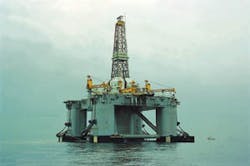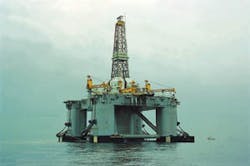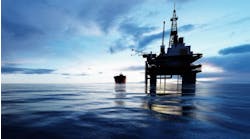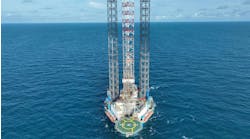First came the pursuit of offshore stability, then mobility, and now water depth
The semisubmersible unit was the other solution to depth limitations of submersibles. Shown here is the Zane Barnes, which has drilled wells in some of the greatest water depths possible (Photo courtesy Reading & Bates).
- The latest mobile drilling rig design is the spar, shown above in production mode. The deep hull restricts mobility, but it can be tethered or spread moored in water depths beyond 10,000 ft (Photo courtesy McDermott).
- The jackup was one solution to the drilling limits of submersible drilling units in the mid-1950s. Today, the three-leg structures allow drilling in depths up to 450 ft.
As long as the water depth did not surpass five feet, the barges could be ballasted down to establish a stable platform. A slot was left open down the center of the barge to ease handling of the BOP stack and drill pipe. These primitive shallow steel barges, the first submersibles, were used for many years afterward.
Steel barges provided stability for the drill floor early in the decade, but later it provided something even more valuable - mobility. Shallow water wooden platforms cost nearly $3 million each to build in the late 1940s. For a gusher, the price was affordable. But, if the hole was dry - and there enough dry holes early on - platforms became prohibitively expensive when water depths surpassed 10 ft.
Shallow water submersible
Platforms with wooden pilings out in the Breton Sound Area off eastern Louisiana in late 1947 were just too expensive for one independent with newly acquired leases. The independent - Barnsdall/Callery/Hurt/Seaboard - decided to call on British engineer John Hayward to try alternatives.Hayward proposed mounting one barge on top of another, and separating the two with columns and an air gap of 10-15 ft, and mounting the mast above the top barge. The lower barge could be ballasted down to the seafloor, leaving the top barge sitting above the waves. The dual barge structure was named the Breton Sound 20.
Why hadn't the stacked barge idea been tried before - probably because most drillers believed the unit would be so heavy it could never be re-floated, or would turn over when released from the seabed muck. Fortunately, nether happened. The idea worked spectacularly, and the Hayward submersible design was copied widely in the years following and exists to this today.
Deepwater submersible
Drillers weren't satisfied with the 20-ft water depth limitation of the Breton Sound 20 design. It was fine for sheltered bays. What they wanted was true offshore capability, with a larger footprint and larger air gap.In 1954, Kerr McGee and Ocean Drilling & Exploration (Odeco) copied the Breton Sound 20 design, but fabricated barges with a much larger footprint, higher barge sides, and higher columns. The Odeco unit, Mr. Charlie, had a water depth capability of 40 ft and could drill far out into the Gulf of Mexico. In recognition of Hayward's achievements, Odeco built one of the offshore units and named it John Hayward.
The submersible evolution continued. In 1956, Kerr-McGee built the Rig 46, which used large cylinders at the four corners of the platform for ballasting instead of a standard barge hull. this new "bottle" unit could drill in 70 ft water depths.
After a sequence of larger units for even greater water depths, Kerr McGee again topped the race by building a giant unit that could work in 175-ft water depths. The unit was triangular-shaped. Each of the three sides was 388 ft in length.
This was the last large offshore submersible unit built. Building larger submersibles that could rest on the seafloor became outrageously expensive, and the industry was forced to find an alternative. The solution came in two forms: jackup and semisubmersible drilling units. The jackup replaced the submersible offshore, and the submersible survived through today as the unit of choice for inshore waters.
A larger number of triangular submersibles, originally slated for shallow offshore drilling, are being upgraded into floating semisubmersible units by Noble Drilling by adding ballast capacity and mooring spreads.
The jackup
US Navy construction battalions in the western Pacific Ocean in the waning days of World War II were using quickly installed docks designed by Leon Delong. The docks were equipped with pilings fastened to the dock hull after they were jacked down into the seabed with a pneumatic cylinder. The entire dock then lifted out of the water to the desired level.After the war, the Delong docks surfaced in Venezuela and off Cape Cod, where radar stations were being erected in open water. In 1954, The Offshore Company contracted to built a Delong barge expressly outfitted for drilling. Barge No. 1 emerged with twelve 6-ft diameter caissons. It was capable of working in 40-ft depths.
The similarity between early submersibles and jackup hulls was unmistakable. Within six months, Bethlehem Steel began constructing a dual hull jackup, Mr. Gus, in which the lower hull was ballasted and jacked down to the ocean floor, effectively lifting the upper hull above the waves. The unit had a water depth capability of 100 ft.
Within 12 months of the launching of The Offshore Company's Barge No. 1, Zapata Offshore took delivery of a revolutionary jackup hull design. The vessel had three legs instead of 10-16, and used reversible electric motor power at the leg.
The designer, Robert LeTourneau, had tried to interest dozens of oil companies in his idea over the previous two years, to no avail. Finally in 1955, Zapata Offshore, headed by former US President George Bush, took a chance.
LeTourneau's design for Zapata was one of the most copied of all jackups in the following years. The design eventually incorporated the ability to work in water depths up to 250 ft and slant the legs outward to gain stability in rough weather conditions.
Today, giant jackups for 350-ft water depths (mild conditions) are working offshore to help extend capabilities for fixed platforms.
In the late 1950s, however, there was no getting around the water depth problem. Then, jackup legs could not span the increasing water depth and provide a fixed support from the seafloor. Something else had to span that distance. What was to come in the years following took two different directions.
The drillship
Offshore California in the early 1950s, production companies were trying to deal with the depth problem in their own way. The climate offshore was mild but the seabed fell away quickly, making piling depths too great for fixed exploratory platforms. A group of producers - Continental (Conoco), Union, Shell, and Superior - formed the CUSS Group, and began to experiment with various forms of a motion-restricted, ship-shape, unballasted vessel.In 1953, the first version emerged as a converted 300-ton Navy patrol craft with a coring and drilling mast mounted on one side. The vessel was named the Submarex. The next step was the conversion of a large US Navy barge to a drilling unit. This barge would become the Cuss I.
The Cuss I featured an interior moon pool beneath the drilling derrick and was tightly moored to six pre-set buoys. A bird-cage shaped drilling base and blowout preventer stack were lowered to the seabed. In order to compensate for the vertical motion of the hull, a slip joint was installed in the drill string. The Cuss I was able to operate in depths up to 350 ft in the roughest weather offered by the Santa Barbara Channel.
After several years of successful drilling, the Glomar class of drillships was developed with larger purpose-built hulls and large moon pools. A catamaran drillship was also developed, but never duplicated. Eventually, the mooring system was dropped when water depths presented too many problems.
Without a mooring system and a riser, the drillship could drill almost anywhere a drill pipe could reach. And, it did in the following years. The Cuss I was able to drill in 11,700 ft of water for the MOHO project. Later, the JOIDES deep drilling project would replace MOHO with even deeper wells.
Dynamic positioning was aided by the use of a taut wire connecting the vessel to the seafloor. Tiny changes in wire angle signaled a series of thrusters to push the vessel back into position. Watch circles of as little as 500 ft in 15,000 ft water depths were possible. After the advent of satellite navigation, the taut wire became a backup device.
Today, giant all-weather, wide-beam drillships exceeding 500 ft are on being constructed with extended masts to carry out multiple drill floor functions. The function of these giant drilling units is to conserve drilling time on projects in 4,000-8,000 ft water depths and surpass the 10,000 ft water depth barrier when the need arises.
The semisubmersible
While the Cuss Group was experimenting with various floating hulls and systems offshore California, a parallel effort was being made in the Gulf of Mexico with ballasted hulls. New studies of partially flooded hulls conducted earlier by the US Navy, the University of California, and Shell Oil Co. indicated that it might be possible to partially ballast down a large hull and remove most of the motion that floating vessels experience at the ocean surface. Shell Oil Co. had a great deal to contribute to this research since it had already investigated seafloor wellhead systems, wellhead re-entry, and remotely operated vehicles.If the surface motion became less of a problem for a deballasted hull, then it might also be possible to separate the motion of the conductor pipe from the hull, and additionally, move the blowout preventer from the deck to the seabed.
The design objective of a deballasted hull with a disconnected conductor (later known as a free-standing or tensioned riser) was to make the total system relatively insensitive to water depth. Jackup depths at the time were limited to under 200 ft.
Several designs using ship hulls and various barges with the rig over the side had been tried in the Gulf of Mexico and off California. They were successful enough to encourage a team of engineers from Shell Oil Co. and Bluewater Drilling to develop a braced assembly of large floodable columns that could be ballasted down far enough to escape pitching and rolling motions. The result was the first semisubmersible - Bluewater No. 1.
The Bluewater No. 2 followed soon afterward, and in 1963 Ocean Drilling & Exploration Co. built the V-shaped semisubmersible Ocean Driller. The Ocean Driller was important to the industry at the time because it could also deballast to the ocean floor and become a submersible. The two-phase concept was a design product of T. S. Graham and Alden Laborde.
Massive semisubmersible vessels developed later were capable of weathering the roughest weather. In fact, the semisubmersible was so effective a platform for drilling that it was later converted to production duty in the North Sea, with hard pipe and flexible production risers linked to seafloor wellheads.
The Spar
The newest generation mobile offshore drilling unit is the spar-shaped unit which features a deep extended hull far below the water line. In the roughest seas, the spar obtains motion stability not only from the floodable chambers, but the deep hull.Like the semisubmersible drilling unit, the spar can be converted to a producing unit, employing either tendons to tension the unit vertically to the seabed or a spread mooring system to position it.
The unit, if plans to build it proceed, is expressly designed for very deep water, and could be the first unit to drill past the 10,000 ft water depth contour.
Copyright 1997 Oil & Gas Journal. All Rights Reserved.




